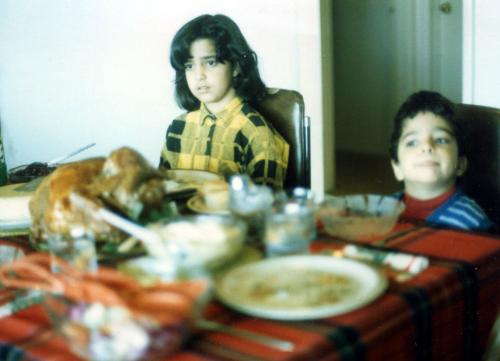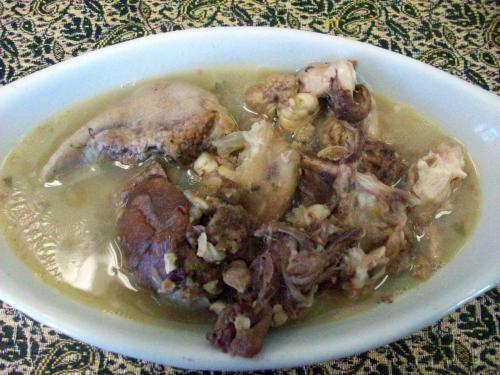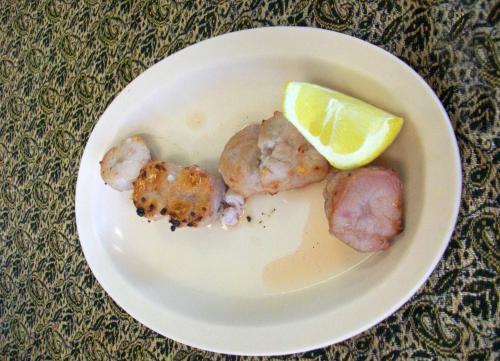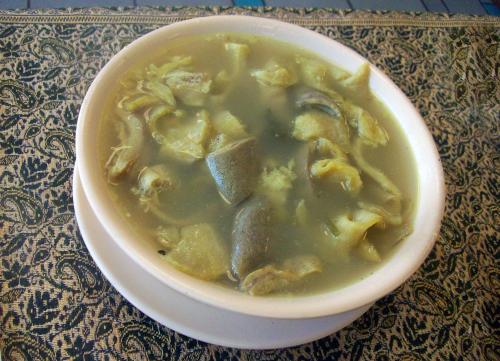Essay by
Porochista Khakpour
New York City, USA
1987, Pasadena, CA.
Five years into living in the United States, we have our first Thanksgiving. I can still see my mother tackling her first turkey in the kitchen when I, nine years old, walk in—a moment not unlike when a child walks in on her parents having sex. We are eating that? I ask, pointing to the white goosepimpled thing, nothing like the stuff of commercials, which featured tan, glazed, muscular entrees like diet program After photos. Later that evening, we gather around it, on a red plaid tablecloth, with paper cups full of Oceanspray cranberry cocktail, while my father takes pictures, the first of many photos we have from family Thanksgivings where I look like not just unthankful, but like an adolescent clinical depression postergirl.

Six years later, at defiant 15, I’ve had it. It’s 1993 and my world is all flannels and ripped jeans and Free Tibet posters and Nirvana and gripes. I am as counterculture as Nineties malls will allow. The first milestone of my teen years is River Phoenix’s death and when the news emphasizes his vegetarianism, I have that aha-moment. Could it be that my problem—what is making me constantly loop Riotgrrrl mixed tapes on my Walkman, what is making me hate my family, what is probably giving me acne—is that food of the man: MEAT?!
And so I decide the dinner table is the perfect setting for my first move of adult independence: I am now a vegetarian, parents.
My horrified mother bombards me with a jumble of facts and fictions: meat makes you tall and strong, meat makes you live longer, meat makes you beautiful (her most potent weapon). My father, less worried, coolly mumbles that he was a vegetarian once but it was a phase. Still, it takes me seven more years to have even a bite of fish, another decade until I try every vegetarian’s downfall—bacon—and finally 18 years until I become a full-blown omnivore.
And yet my herbivore love affair was lustier than most. A first grade questionnaire reveals that my “favorite food” was “SALLAD.” To this day I can’t imagine starting the day without a variety of green leafy things in the blender: my beloved green juices. Vegetarian cuisines have been the love of my life. Hay and cud, my mother always grumbled, seeing it as a teenage rebellion I never outgrew. Don’t come running to me when being a cow kills you.
2010, Santa Fe, NM.
And then it does: I seem healthy for most of my life until 2010. I move to Santa Fe in late summer and notice I’m not getting over high-altitude discomfort. A doctor’s office visit reveals I am not just anemic as I suspected, but have the lowest blood sugar my doctor has ever seen, plus very low insulin. Adrenal and pancreatic tumors, diabetes 2 and then diabetes 1, PCOS, and celiac, are all possibilities. My diet is probed, and while I go on about my green juices, some other things leak out: entire weeks of potato salad lunches, whole boxes of pasta as dinner-for-one servings, and a daily allegiance to beers of stout and porter variety. She denounces me as a carb and sugar addict, demands an urgent end to all of it, and finally utters the one word that has become my fate: paleo. The trendy caveman diet of animal protein, fat, and veggies is to be my new gastro-religion. For many minutes we argue—from ethics (I rescue dogs!) to romantics (my new fiancé is vegan!)—but she tells me my life depends on it so that’s the end of that.
Overnight a carnivore in me is born. There I am at the grocery store trying for the first time to pick out meats with the awkwardness of a man selecting pantyhose for his wife. At restaurants I feel mistaken for an Atkins-crazed trophy wife, ordering bunless-this and riceless-that, and I crumble under overly empathetic looks from other women as I pass on dessert. Plus, I have to endure watching my fiancé enjoy all the heartbeatless eats we once shared. It seems all we have in common now are some vegetables, I glumly tell my parents over the phone.
Meat makes you beautiful, my mother repeats, as if I’m 15 again but this time I eat my dinner.
2011, Los Angeles, CA.
There is meat and then there is meat, the type that resists euphemism. Of these, kaleh pacheh is king. It’s what renowned Persian chef Najmieh Batmanglij translates to “lamb’s head and feet stew”—just what it sounds like: whole sheep head with eyeballs, tongue, brains, hooves, all stewed for hours in water, onions, and garlic. This is a breakfast meal Iranians often eat before dawn. Anecdotal lore indicates that grandmothers and aunts generally tackle this for sake of their men who, my father hypothesizes, bond over it as a “macho thing.” My mother has always boasted a love of it; I have feared it my entire life.

So when I decide to return home for the first time in years, more extreme forms of meat-eating jokingly surface and then so does the ultimate bogeyman of that funny, the pinnacle of carnivorism: kaleh pacheh.
My father is the first to voice dread. Apparently, his older sister had almost run away from home when their mother tried to make it. If you try it, I don’t want to know, he insists.
But I argue that it’s hypocritical of us to be digging into a drumstick and then drawing the line at a head or hoof. I mean, what animals parts do hot dogs come from? If I am going meatward, I might as well look my meat in the eye: literally.
My mother is an easy in. After flirting with the idea of making it (I will move out, my father threatens), she suggests a few cafes that do, most famously Westwood’s Canary Café, and so we head over for a late breakfast.
The “Specials” section of Canary’s menu is an extravagant resting place of Iranian extreme cuisine: heart, kidney, liver, “halem” (imagine if oatmeal included ground turkey, my mother explains), “donbalaan” (lamb testicles, politely left description-less on the menu), “sirabee” (lamb stomach lining soup), and, of course, “kaleh pacheh.” Our waitress—a young, wisecracking Tehrangelina—winces when she sees us two proper ladies—my mother in a cardigan and pearls, me in a dress and heels—order stomach soup, testicle apps, and head and hoof stew.

We began with the plate of small pinkish balls, unmistakable in their plain-as-naked-day visuals. My mother polishes off two with enviable ease; I manage a shaky forkful of a half but fortunately it’s sausage-like enough to remind you of, well, sausage.
Silence, sighs. My mother smiles sweetly, I smile sweetly back, but behind the smiles, we are clearly cowboys at a showdown. Who will put their utensils down first?
We got to do the kaleh pacheh fast, while it lasts, my mother finally breaks the silence. It goes to . . . jelly
Congeals?
My mother nods bleakly; I nod at the face in my bowl.
As we poke around with our spoons, the waitress pops up, reading the thing like a map—that’s eyeball, that’s tongue, that’s definitely brains. For a while I just take spoonfuls of the broth—mildly creamy with a surprising tanginess (I refuse to think too hard about the source of the tang)—but eventually after witnessing my mother relish her brains, I slice into some tongue. Its texture: traumatizingly tonguey; its taste: generically meaty; my feeling: shockingly badass.
Sirabee is last, but not least. It’s a greenish soup of thick yellow ribbons that could have been tagliatelle if you are as invested in denial as I am. The smell, something else: the exact stench of Chinese acupuncture offices. When I finally go for it, it is just a weird, bitter, rubbery soup. My mother’s first misstep—a near-gag—gives me the advantage, finally the one dish I have her beat on.

Still, I have to tip my hat to this woman whose whole life has been nonfat fad diets putting down the bulk of the meal. And I imagine her hat-tip to me for going where no vegetarian has gone before, I must assume: the most awful of offal.
On the drive home, we sit full and exhausted in a heavy silence, like homebound soldiers after years of battle. What can we say? We have eaten something with a face—we have eaten its face actually. We are blackbelt meateaters. Still, that night my mother does the unthinkable: how about vegetarian for dinner? At Green Earth Vegan in Pasadena, where my mother wolfs down her “soy chick’un salad” and I my stew of pumpkin, eggplant, and tofu, we give silent thanks at the altar of the herbivorism. I resist commenting that our happy endpoint is back to the point where it had all began: a vegetable rebellion.
